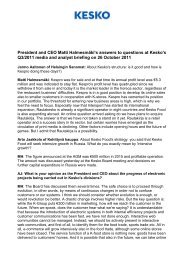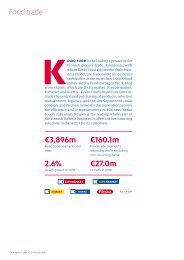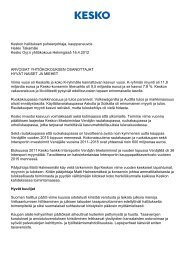Kesko's Annual Report 2009
Kesko's Annual Report 2009
Kesko's Annual Report 2009
You also want an ePaper? Increase the reach of your titles
YUMPU automatically turns print PDFs into web optimized ePapers that Google loves.
62 Kesko’s year <strong>2009</strong><br />
Financial planning takes place in the subsidiaries, divisions<br />
and the Group where rolling plans, each for a 15-month period,<br />
are made. The plans are updated quarterly, and any significant<br />
changes are taken into account in the monthly performance<br />
forecasts. Any deviations between the plan and the actual result<br />
are analysed by the company, division and Corporate Accounting,<br />
and the reasons are reported to the division and Corporate<br />
Accounting every month.<br />
The performance reports provided monthly for the Group’s top<br />
management comprise the subsidiaries’, divisions’ and the consolidated<br />
income statements and balance sheets. Each subsidiary<br />
is primarily responsible for the financial reporting and the correctness<br />
of its figures. The financial management and the controlling<br />
function of each division analyse the respective division’s<br />
figures, while Corporate Accounting analyses the whole Group’s<br />
figures. The income statement and the balance sheet are analysed<br />
monthly at the company, division and Group level, based<br />
on the documented division of duties and specified reports. This<br />
enables a real-time knowledge of the financial situation, as well<br />
as real-time response to possible defects. The performance<br />
reports provided for the top management also include Grouplevel<br />
monitoring of sales on a weekly, monthly and quarterly<br />
basis.<br />
Public performance reporting comprises interim reports, the<br />
annual financial statements and monthly sales reports. The same<br />
principles and control methods are applied to the public performance<br />
reporting as to the monthly performance reporting. The<br />
Audit Committee reviews the interim report and the financial<br />
statements and gives a recommendation to the Board of Directors.<br />
The Board of Directors approves the interim report and the<br />
financial statements before they are published.<br />
Accounting policies and<br />
financial management IT systems<br />
The Kesko Group has adopted the International Financial <strong>Report</strong>ing<br />
Standards (IFRSs) endorsed by the European Union. The<br />
accounting policies adopted by the Group are included in the<br />
accounting manual, updated as the standards are amended. The<br />
manual contains guidelines for stand-alone companies, the parent<br />
company, and instructions for the preparation of consolidated<br />
financial statements.<br />
The Kesko Group’s financial management information is generated<br />
by division-specific enterprise resource planning systems,<br />
via a centralised and controlled common interface, into the<br />
Group’s centralised consolidation system, to produce the Group’s<br />
main financial reports. The key systems used in the production of<br />
financial information are certified and secured by back-up systems,<br />
and they are controlled and checked regularly to ensure<br />
reliability and continuity.<br />
Risk management and internal audit<br />
Risk management is an integral part of Kesko’s<br />
management<br />
Kesko’s risk management is proactive and an integral part of<br />
management and day-to-day activities. The objective of Kesko’s<br />
risk management is to ensure the implementation of Group<br />
strategies, the delivery of customer promises, the maintenance of<br />
shareholder value, and the continuity of business. Efficient risk<br />
management is a competitive advantage for Kesko.<br />
The risk management policy approved by the Board of Directors<br />
guides risk management in the Kesko Group. The policy<br />
defines the objectives, principles, responsibilities and key practices<br />
of risk management. Kesko divides risks into strategic,<br />
financial, operational and damage/loss risks.<br />
In the Kesko Group, a risk is defined as any kind of uncertainty<br />
that may lead to:<br />
• a failure to exploit business opportunities,<br />
• events or reasons which prevent or hinder the attainment of<br />
objectives or have other unwanted consequences.<br />
The Kesko Group applies a business-oriented and comprehensive<br />
approach to risk assessment and management. This means that<br />
key risks are systematically identified, assessed, managed, monitored<br />
and reported as part of business activities at the Group,<br />
division, company and unit levels in all the countries where<br />
Kesko operates. Risk identification and assessment play a key role<br />
in Kesko’s strategies and rolling planning.<br />
Kesko has a uniform risk assessment and reporting system.<br />
Risks are identified and prioritised by assessing the impact and<br />
probability of their materialisation, and the level of management.<br />
An owner is named for all risks and the most significant<br />
risks are analysed in detail to find out causes and effects. The<br />
risks classified as critical are regularly dealt with by the Corporate<br />
Management Board, which also monitors the actions taken. The<br />
development of the risk situation is also assessed on the basis of<br />
the progress made through these actions and the changes in<br />
external factors, for example. In risk assessments the time span<br />
is one year, except for strategic risks where the span is 3–5 years.<br />
The outcome is a clearer picture of the scope, mutual relations<br />
and expected trends of the risks.<br />
The management of financial risks is based on the Group’s<br />
treasury policy, confirmed by Kesko’s Board of Directors. The<br />
Group Treasury is centrally responsible for funding, liquidity<br />
management, debt investor relations and the management<br />
of financial risks.<br />
Providing insurance cover is part of Kesko’s risk management,<br />
and the insurance policy confirmed by Kesko’s Board of Directors<br />
defines the principles of providing insurance. The aim is to<br />
ensure that the Group’s employees, property, business and liabilities<br />
have proper and economical insurance cover, while taking<br />
account of legislative requirements, and the Group’s current risks<br />
and risk-bearing capacity. The Group’s risk management functions<br />
are responsible for providing Group-level insurance















